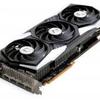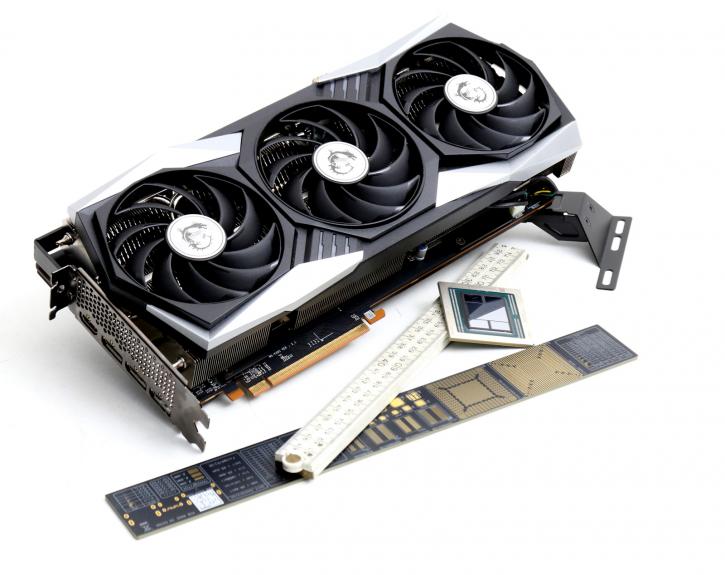Introduction
MSI Radeon RX 6800 XT Gaming X TRIO review
Welcome to the last review we'll post in the year 2020; we're one day away from 2021 and will end the year with a review for MSI. MSI submitted their all-new Radeon RX 6800 XT graphics card for review, and this one is a bit more special, though, as it has been outfitted in the Gaming X TRIO style. Yes, you'll see proper cooling applied to the primary GPU area. The result is a graphics card that looks both stunning and is extremely silent as well. The card was fabbed around a custom PCB, premium components, a triple fan TriFrozr cooler, increased clock frequencies, as well as an increased power limiter. This is one of the best performing acoustic products in its default operating modes. It has been a long wait for AMD and, sure, us. When the first NAVI based graphics cards were launched, they became well respected. The 5600 and 5700 series does offer some good performance. But during that launch, everybody was already talking about one thing, where is Big Navi? It's now November 2020 as we write this, and here we are, the world completely changed. Next to everything COVID-19 related, in the world of graphics technology, a new dynamic was added, Raytracing. Or, I should say DirectX Raytracing (DX-R). NVIDIA was pioneering two years ago with their RTX 2000 series already, and AMD made the call to delay that for the original Navi GPU. As the graphics landscape changed somewhere done the line, so this the roadmap for AMD change. Microsoft and Sony consoles embedded with AMD technology revealed that Raytracing was going to be supported. And that did set the trend for the desktop graphics card we see announced. AMD announced three graphics cards based on Big Navi; they all hold the very same GPU, just binned and somewhat 'weakened.' Interesting to learn is that the new GPUs are fabricated on an optimized 7nm node derived from TSMC. The cards will be PCIe 4.0 interface compatible. The number of hardware-accelerated RT cores is set up in a 1:1 creation towards the CU count. The cards released all fall into a high-end to the enthusiast-class category and are priced as such. The flagship Radeon Radeon RX 6900 XT is to cost 999 USD, the RX 6800 XT costs 649 USD, and the Radeon RX 6800 will cost 579 USD with performance levels matching the completion RTX 3070 running up-to the RTX 3090. It does that by many architectural improvements, but sure, increasing transistor real-estate comes into play as the shader processor count has nearly doubled up over last generational products. Three SKUs with a very similar design, all based on the same chip I stated, and that statement stands. The Radeon RX 6900 XT 16GB GDDR6 graphics card will get the full 80 CUs enabled. Multiply that with 64 shader units, and you'll count 5120 shading/stream processors. This card gets 16 GB of GDDR6 memory based on a 256-bit memory bus. So that means 512 GB/s of memory bandwidth and, in fact, would be equal to the bandwidth of the RTX 3070. The TDP listed is 300 watts. This fully enabled Big Navi based chip has a whopping 26.8 billion transistors. The clocks are the same as the 6800 XT at a 2250 GHz boost and 2015 MHz game clock. According to AMD (below), this card will battle with the GeForce RTX 3090. The card will become available on December 8th for 999 USD.
Radeon RX 6800 XT
The 6800 XT, which we review in this article, receives 72 activated CUs multiplied by 64 shader units is 4608 shading processors. This card gets 16 GB of GDDR6 memory based on a 256-bit memory bus, not to confuse the new GDDR6X memory NVIDIA uses for RTX 3080 and 3090. So that means 512 GB/s of memory bandwidth and, in fact, would be equal to the bandwidth of the GeForce RTX 3070. The TDP listed is at 300 watts for this product. The 2250 GHz boost clock is spectacular. However, the more average game clock is listed at 2015 MHz. New is a 128 MB infinity cache, which we need to explain in our final review, of course. The card is to battle the GeForce RTX 3080 in performance. This graphics card will cost you a sweet sum of 649 USD. A derivative is the Radeon RX 6800; this actually the same card as the 6800 XT, but let's call this somewhat castrated and probably the favorite card for many BIOS tweakers ;) It is more restrained with 60 CUs and thus 3840 Shading processors. It's 1815 MHz game clock and 2105 MHz Boost clock frequency is a notch lower as well. This card will battle with the GeForce RTX 2080 Ti and RTX 3070. The price is a notch better at 579 USD.
| Desktop | ||||||||
| GPU | Stream Processors | RT Cores | Max Boost GPU clock (MHz) | RAM type | RAM volume (GB) | RAM bandwidth (GB/s) | RAM width | TDP (watts) |
| Radeon RX 6900 XT | 5120 | 80 | 2250 | GDDR6 | 16 | 512 | 256-bit | 300 |
| MSI RX 6800 XT Gaming X | 4608 | 72 | 2285 | GDDR6 | 16 | 512 | 256-bit | 300 |
| Radeon RX 6800 XT | 4608 | 72 | 2250 | GDDR6 | 16 | 512 | 256-bit | 300 |
| Radeon RX 6800 | 3840 | 60 | 2105 | GDDR6 | 16 | 512 | 256-bit | 250 |
| Radeon RX 5700 XT | 2560 | 1605 | GDDR6 | 8 | 448 | 256-bit | 225 | |
| Radeon RX 5700 | 2304 | 1465 | GDDR6 | 8 | 448 | 256-bit | 180 | |
| Radeon VII | 3840 | 1400 | HBM2 | 16 | 1024 | 4096-bit | 300 | |
| Radeon RX Vega 64 | 4096 | 1247 | HBM2 | 8 | 484 | 2048-bit | 295 | |
| Radeon RX Vega 56 | 3584 | 1156 | HBM2 | 8 | 410 | 2048-bit | 210 | |
| Radeon RX 590 | 2304 | 1469 | GDDR5 | 8GB | 256 | 256-bit | 185 |
All three cards released by AMD and their board partners will receive GDDR6 memory, 16 GB of them. Again that's for all three cards. So that means a 256-bit wide memory bus. However, AMD has got a few tricks up their sleeves architecture wise, as they added a big phat cache into the GPU. We'll talk more about that later, though. power consumption wise we're talking anywhere from 250 running up-to 300 Watts; these are values that sit a bit better than team green, where an RTX 3090 can reach 350 Watts even. All cards are DirectX Ultimate compatible. That naming is just a placeholder for a few extra feature levels, such as DirectX Raytracing (DXR), Variable Rate Shading (VRS), Mesh Shaders, and Sampler Feedback.
MSI Radeon RX 6800 XT Gaming X TRIO 16G
MSI is back in the house with their familiar TRIO series. And we have to say it, the cooler looks admirable on an MSI Radeon product, but not as nice as the NVIDIA version; see that NV cooler is all dark-themed, this one has silver colored insert elements, which we quarrel on a bit. Other than that, you can expect a product with a nice fast Turbo at 2285 MHZ (2250 MHz reference) and, of course, that 16GB of graphics memory. The product is unique because it offers a TRIO TriFrozr cooler cooling down all primary elements (GPU+VRM). The card has a length of 32cm and uses a 2.7 slot design. You can amp it up with dual 8-pin PCIe power connectors; the card is bound to please and tease many; obviously, it comes fitted with a backplate. In the I/O area, the card includes three DisplayPort 1.4 ports, one HDMI 2.1 connectors. The 16GB GDDR6 memory clocks in at 2000 MHz (16 Gbps effective). All that premium does increase pricing, $849 (US/EUR). And yeah, that is a tough one to swallow as reference cards sell at 649 USD (or at least they should sell at that money), so that's a price premium of 200 USD, holy cow batman. As always, we have a lot to talk about and show you; next page, please.


